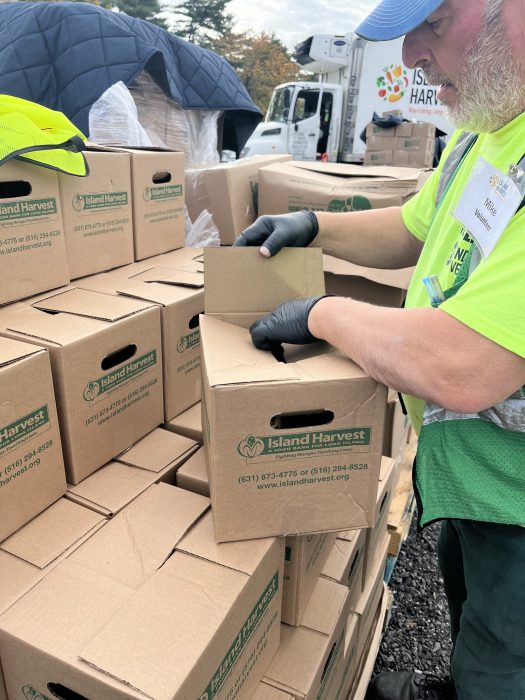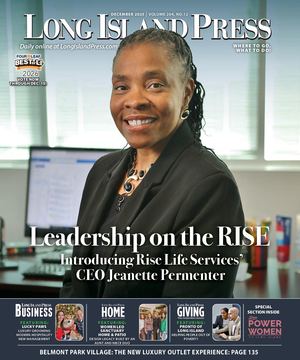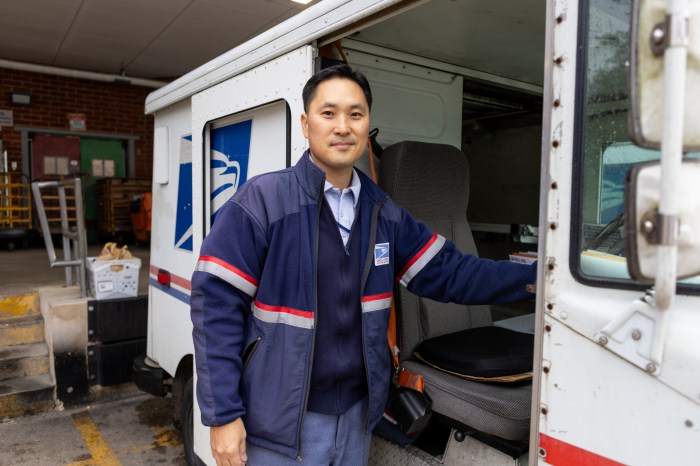Tens of thousands of Long Islanders who rely on SNAP benefits, also known as food stamps, won’t be getting them on time or in full this month because of a lapse in funding caused by the ongoing federal government shutdown.
SNAP benefits, which have never lapsed before, were paused on Nov. 1 for the one in eight Americans who rely on roughly $8 billion in SNAP benefits monthly. Two federal judges ruled Friday that the Trump administration had to fund the program during the government shutdown. Court filings out of Rhode Island Monday said the Department of Agriculture will disburse its entire $4.65 billion SNAP contingency fund to support the program, covering only about half of each eligible household’s benefits for November.
Long Island Cares and Island Harvest, Long Island’s two food banks, said they are doing what they can to fill the food and funding gap created for the 184,000 people across Nassau and Suffolk who receive over $40 million worth of SNAP benefits each month, But their help can only go so far.
“The truth of the matter is that with 184,000 people receiving SNAP on Long Island, that’s millions each month that they were counting on. We can’t food bank our way out of that,” said Island Harvest CEO Randi Shubin Dresner. “The generous funding that we’re getting is important. It’s going to feed people who are in need, but it won’t close the gap. The only way to close this gap is to get SNAP dollars back in the system. When people can’t put the food on the table for their families, it’s grim.”
Both New York State and Nassau County have offered additional funding to Long Island food banks during the lapse in SNAP funding: Gov. Kathy Hochul has committed $30 million to food banks across the state and County Executive Bruce Blakeman has committed $50,000 a week to Island Cares and Island Harvest until SNAP benefits are resumed.
Dresner said the additional money would allow her food bank to purchase tens of thousands of pounds of food, but it wouldn’t be enough to completely fill the need she expects to see from across the island, especially since food banks are already operating with “challenges” after SNAP experienced cuts in the Big Beautiful Bill Act passed by Congress in July.

Both Dresner and Long Island Cares representative Peter Crescenti said they’ve seen an uptick in both people seeking out food and people willing to donate to help them meet the increased need. The increase in need is driven by both the reduction in SNAP benefits and federal workers, who are missing paychecks due to the shutdown, they say.
Both food banks said that monetary donations and gift cards are the most helpful things for them to receive from the community, as that allows them to purchase perishable food, which they can’t accept from the public, in bulk at a lower cost.
Perishable food like produce, meat, eggs and milk is a particularly critical resource for struggling families, said Rick Lewis, the CEO of the Mid Island JCC, which operates the Rudman Family Food Pantry and partners with Island Harvest.
“The replacement for SNAP benefits really is perishable food like meat, vegetables, eggs and milk, and that’s the kind of food that we need to source quickly so that these families can be taken care of,” Lewis said. “The crisis truly is going to hit when these pantries can’t provide the perishable food: when there’s no eggs, there’s no chicken, there’s no milk. That’s really what sustains a family. We’re not talking about cereal here, we’re talking about a real dinner.”
His food pantry has seen a significant increase in food and monetary donations, bringing in approximately $6,000 and 1,100 pounds of non-perishable food donations over the past week. He added that he has already seen an increase in people seeking help over the past week, and anticipates the need will double in the coming weeks.
Despite the increase in donations from the community and local government, the extent to which the island’s food banks will be able to meet the increased need depends on how long the lapse in funding lasts, both Dresner and Crescenti said. And, even once SNAP resumes full funding, it will still take time for those benefits to reach families, meaning the issue will stretch on for an indefinite period.
“Even if they fund SNAP, or they attempt to fund SNAP today, it’s going to take time before that money filters through the system,” Dresner said. “We’re in this now, and we have to do what we can to make sure we can help people who are struggling and try to release some of the stress that they’re dealing with right now.”
Life’s WORC CEO John Pfeifer, whose organization supports disabled residents in group homes by using SNAP benefits to offset a portion of food costs, said that though SNAP reductions haven’t yet impacted his residents who rely on them, the cut is “looming.”
“SNAP is part of their entitlements,” Pfeifer said of the residents Life’s WORC supports. “This is part of their benefit package. These are people that…are heavily reliant on this type of government entitlements. When that’s cut, their programming is directly impacted.”
He said the cuts may cause the organization to have to alter the way it purchases food and reduce choice for residents, but that all will receive balanced nutritional meals through the shutdown.
Monday’s court filing states that the partial SNAP payments must be made no later than Wednesday, Nov. 5. The court said the Department of Agriculture could have chosen to make the full November payment of SNAP funds by using Section 32 Child Nutrition Program funds and other unspecified funds, but elected not to, citing a need to preserve those contingency funds.
“Ultimately, USDA has determined that Section 32 Child Nutrition Program funds must remain available to protect full operation of Child Nutrition Programs throughout the fiscal year, instead of being used for SNAP benefits,” the Rhode Island court filing reads. “Section 32 Child Nutrition Program funds are not a contingency fund for SNAP. Using billions of dollars from Child Nutrition for SNAP would leave an unprecedented gap in Child Nutrition funding that Congress has never had to fill with annual appropriations.”
The Trump administration has stated that roughly $4 billion in additional funds would be required to fully fund SNAP benefits through November.
Crescenti said that until SNAP funds are completely back, he wants people to know that Long Island Cares and their local food pantries are there to support them and are doing everything they can.
“Until funding comes from Washington, what people should know right now is Long Island Cares is here for them. We’re pumping on all cylinders to get food out to people in need,” Crescenti said. “We are operating with dozens of volunteers every week, packing boxes as fast as we possibly can, getting our trucks out on the road as fast as we can, and dropping that food off to the pantries, the churches, the soup kitchens, the shelters. We are operating on a red alert.”
You can find your local food pantry by visiting https://www.licares.org/find-food/.



































